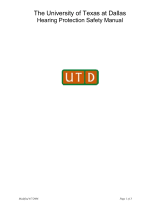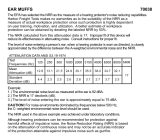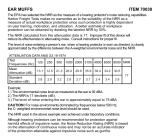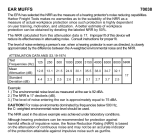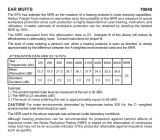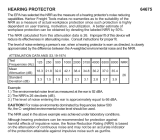
E•A•RLog is a registered trademark of Aearo Company. Copyright 1996. First printing 1980.
LIT. CODE 30296 9/98 AG
sion. Therefore it is important to
inspect or reissue ‘’permanent’’
HPDs on a regular basis. This may
be 2-12 times per year or more,
depending upon the HPDs that
are utilized.
7. Abuse - Employees often modify
HPDs to improve comfort at the
expense of protection.
12,13,14
These
techniques include springing ear-
muff headbands to reduce the ten-
sion, cutting flanges off of pre-
molded inserts, drilling holes thru
plugs or muffs, removing the ca-
nal portion of custom earmolds, or
deliberately obtaining undersized
HPDs.
Protection vs. Percentage Time Worn
The HPD RW utilization problems out-
lined in the preceding section explain
why the RW attenuation of HPDs is so
much lower than typical manufacturers’
laboratory data would indicate (as was
extensively discussed in EARLog # 4
1
).
In addition to this problem we must con-
tend with the possibility that employees,
regardless of how well they wear an
HPD, may not wear it during their en-
tire work-shift or period of noise expo-
sure. This will reduce their effective daily
protection.
Noise induced hearing loss has been
shown to be a function of the cumula-
tive A-weighted noise exposure incident
upon the ears.
15,16
Adherents of this
theory propose that the hearing levels
of a noise exposed population can be
estimated from a knowledge of their
equivalent continuous noise exposure
level (L
eq
). The L
eq
is the level of con-
tinuous A-weighted noise that would
cause the same sound energy to be ex-
perienced in an 8-hour day, as resulted
from the actual noise exposure. This
leads to the 3 dB trading relationship,
that is, if the exposure level is increased
by 3 dB, the exposure duration must be
reduced by 1/2. A similar approach is
embodied in the U.S. Occupational
Safety and Health Act
17
, except that the
trading relationship is 5 dB. The impli-
cations of the cumulative energy theory
with regards to the protection afforded
by HPDs, were first discussed by Else.
18
They are presented graphically in Fig-
ure 4, with suitable modifications to con-
form with the OSHA 5 dB trading rela-
tionship.
The data in Figure 4 can be utilized to
determine the Time Corrected Noise
Reduction Rating (NRR) as a function
of the percentage of time that the HPD
is worn in the noise. We first assign an
NRR value to the HPD in question - ei-
ther the manufacturers’ labeled NRR or
preferably a RW estimated NRR. If, for
example, the HPD had an assigned
NRR = 25, then its Time Corrected NRR
would be only 20 dB if it was not worn
for just 15 minutes during each 8 hour
noise exposure. This clearly demon-
strates that HPDs must be comfortable
enough to be worn properly for ex-
tended periods. Attenuation and com-
fort must both be considered when se-
lecting an HPD.
Neither low attenuation nor low comfort
devices are acceptable for standard in-
dustrial use. Comfortable, user accept-
able HPDs, with real world NRRs suit-
able for the prevailing environmental
sound levels will be necessary to pro-
tect your employees’ hearing.
References and Footnotes
Berger, E.H. - The EARLog series is available upon
request from Aearo Company.
Von Gierke, H.E., and Brown, D.R. (1953).
Protection of the Ear From Noise: Limiting Factors
in Benox Report, The Univ. of Chicago. ONR
Project NR 144079, Chicago, IL.
Nixon, C.W. (1979). Hearing Protective Devices:
Ear Protectors in Handbook of Noise Control (2nd
Edition),McGraw-Hill, New York, NY.
Zwislocki, J. (1957). In Search of the Bone-
Conduction Threshold in a Free Sound Field, J.
Acoust. Soc. Am., Vol. 29, No. 7, p. 795-804.
Gasaway, D.C. (1971). Personal Ear Protection.
USAF School of Aerospace Medicine, Report No.
SAM-TR-71-13, Brooks AFB, TX.
Anderson, C.M.B., and Whittle, L.S. (1971 ).
Physiological Noise and the Missing 6 dB.
Acustica, Vol. 24, p. 261-272.
Tonndorf, J. (1972). Bone Conduction in
Foundations of Modern Auditory Theory, Vol. II
,
Academic Press, New York NY.
Gorman, A. G. (1980). New Design Concepts in
Personal Hearing Protectors presented at the
International Symposium on Personal Hearing
Protection in Industry, Toronto, Canada.
Data from E-A-RCAL
SM
Laboratory experiments in
progress.
Maas, R.B. (1972). Industrial Noise and Hearing
Conservation in
Handbook of Clinical Audiology
(1st Edition), Williams and Wilkins Co., Baltimore,
MD.
Ohlin, D. (1975). Personal Hearing Protective
Devices: Fitting, Care and Use. U.S. Army
Environmental Hygiene Agency, Report No. AD-
AO21 408, Aberdeen Proving Ground, MD.
Riko, K., and Alberti, P.W. (1980). How Ear
Protectors Fail: A Practical Guide presented at the
International Symposium of Personal Hearing
Protection in Industry, Toronto, Ontario.
Royster, L.H., and Holder, S.R. (1980). Personal
Hearing Protectors: Problems Associated with the
Hearing Protection Phase of the Hearing
Conservation Program presented at the
International Symposium on Personal Hearing
Protection in Industry, Toronto, Ontario.
Mellard, J.M., Doyle, T.J., and Miller, M.H. (1978).
Employee Education - The Key to Effective Hearing
Conservation. Sound and Vibration, Vol. 12, No. 1,
p. 24-29.
Robinson, D.W. (1971). Estimating the Risk of
Hearing Loss Due to Exposure to Continuous
Noise in Occupational Hearing Loss, Academic
Press, New York, NY.
Atherly, G.R.C., and Martin, A.M. (1971).
Equivalent-Continuous Noise Level as a Measure
of Injury from Impact and Impulse Noise. Ann.
Occup. Hyg., Vol. 14, p. 11-28.
OSHA (1971). Occupational Safety and Health Act,
Federal Register, Vol. 36, No. 105, 29CFR1910.95.
Else, D. (1973). A Note on the Protection Afforded
by Hearing Protectors - Implications of the Energy
Principle. Ann. Occup. Hyg., Vol. 16, p. 81-83.
PERCENTAGE TIME WORN
TIME CORRECTED NRR (dB)
TIME-CORRECTED NRR
AS A FUNCTION OF WEARING TIME
(USING OSHA 5 dB TRADING RELATIONSHIP).
30
5
50
10
15
20
25
25
20
15
10
5
Figure 4
75 88 94 98 99 99.5 99.9
∞
240 2.5 0.510 530120 60
TIME NOT WORN (MINUTES) DURING 8 HOUR EXPOSURE
EXAMPLE (SEE TEXT)
ASSIGNED NRR
1.
2.
3.
4.
5.
6.
7.
8.
9.
10.
11.
12.
13.
14.
15.
16.
17.
18.




